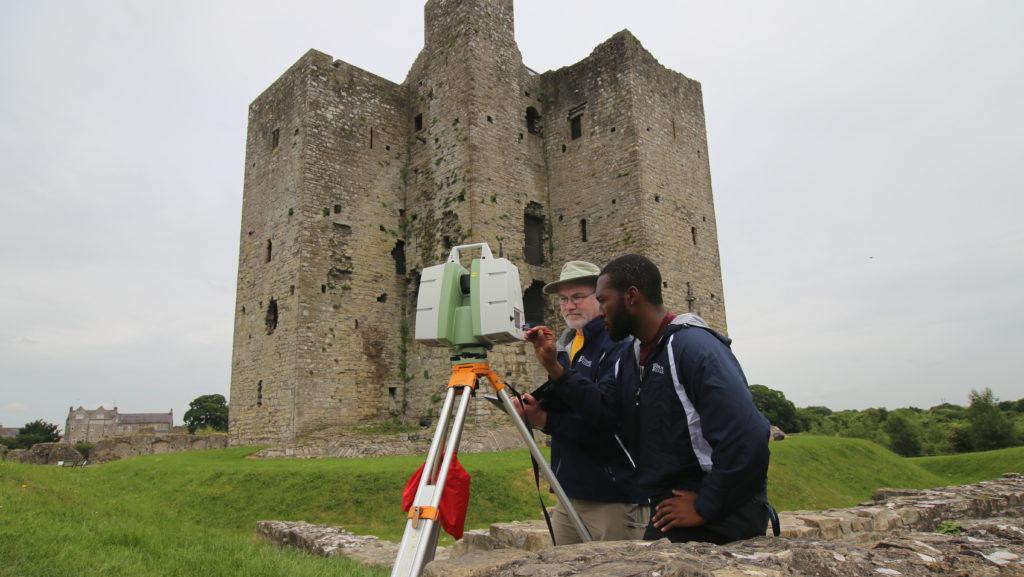Arriving on the site at 9 a.m. every day in rural Ireland, a research team of four Ithaca College physics students and two professors had one goal: to complete a comprehensive scan of a thousand-year-old medieval castle.
Over this past summer, the team — junior Harrison Kesel, sophomore Chidi Anyata, senior Benjamin Bouricius and senior Tom Steele — traveled with Michael Rogers, a professor in the Department of Physics and Astronomy, and Scott Stull, an assistant professor in the Department of Anthropology, on a monthlong trip to Trim, Ireland, to produce a 3-D scan of Trim Castle and its surrounding historical structures.
3-D scanning is a process that involves scanning objects to gather data that can produce digital models of those objects. The team is now exploring these digital models on computers — like a virtual walk–through.
The Trip
Planning for the trip began in April 2015 when Rogers and Stull attended a Society for American Archeology meeting. During this meeting, Stull spoke with the Irish Archaeology Field School. Stull, whose interest is in landscape, asked about Trim Castle for his own personal research. IAFS put him in touch with the Irish Office of Public Works, which helped him get permission from the government to scan the castle.
After receiving permission, Rogers put in a budget proposal at the college, and the trip was approved. From there, he formed a team of students to work as paid researchers by holding a recruiting night put together by physics professors with special summer projects. Most of the students who applied had prior experience with the two high-end Leica 3-D scanners the college owns.
Steele, who is currently involved with a project to 3-D scan the college’s campus, said all of the students were eager to go on the trip.
“I don’t think a single one of us took any convincing,” Steele said.
Stull said the 3-D scan of the castle and the landscape will help them better illustrate the many viewpoints of the castle. He said some of the viewpoints, such as the windows of the castle, are not physically accessible because they have been blocked off or are in a location with no floor behind it. The 3-D scan of the castle will help illustrate viewpoints of the castle that cannot be seen in person, Stull said.
“We can identify what those viewscapes are from the digital model in a way that you can’t do in real life today,” Stull said. “We are taking all of that information and using it to look at it in a new way.”
The raw data gathered by the scanners generally has unwanted elements in it, such as images of tourists or birds, Rogers said. To fix that, the scan must be cleaned up and processed on the computer, which is currently being done by Kesel and Anyata.
Once the data is finished being processed, Rogers said, he plans on sending a copy of it to the Irish Office of Public Works. And next April, Rogers and Stull will give a presentation in Oxford about the viewscape of Trim Castle.
The Process
Bouricius said the bulk of the scanning for this project was done in groups of two. Each group had “work” days and “off” days. The typical workday started with the students’ heading off to the site at 9 a.m. They traveled in a rental car from the Knightsbrook Hotel to the castle, which was about a mile away. At the site, the students positioned the 3-D scanners at stations around the castle and began mapping. These scanning stations were crucial to the process, Bouricius said.
“You need fixed points that you can come back to and they’ll be in the same spot,” he said. “If you put a nail in the ground with a flag on it, you’ll be amazed by how much that can actually move around over the course of several days. It might be a small amount, but that will play into the scan.”
Rogers said there were a total of 76 scanning stations and the students typically worked through several stations each day. At the stations, the students used the 3-D scanners to do a context scan of a given area. Then they conducted a detailed scan on features of interest in that area that captured data on approximately every 5 millimeters of surface area.
On off days, the students would explore the town and also visit the Black Friary site, a local archeological field–school site where senior Olivia McNeely was doing fieldwork as part her anthropology major requirement. McNeely was being supervised by Stull. During this time, the research team also got to enjoy spending time with the locals.
“When you go abroad, if you stay some place for more than four days, people will start to realize you’re not a tourist,” Rogers said. “So one of the things that happens is that as soon as they realize you’re not a tourist, people chat a lot more.”
After completing the scan of Trim Castle, the researchers had extra time remaining in their trip. They used the extra time to scan several surrounding landscapes — Old City Wall, the Yellow Steeple and the Black Friary site — to help give better context to the Trim Castle scan.
“We had given ourselves a month because we weren’t quite sure what obstacles we would run into, and we ended up making really good time on the Castle Wall and the outside of the Keep,” Bouricius said. “The fact that we could get everything in the surrounding area into the same scan — that just hasn’t really been done before.”








